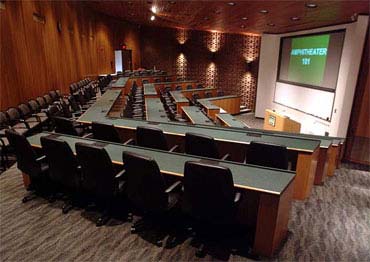Lecture Capture System Pulls Double Duty at Michigan State
The Executive MBA program at Michigan State University is an 18-month, team-based program. Each class enters the program together, taking courses in the same sequence and sharing the entire academic experience together. The rigid structure, with four or five team members having to stay in step with each other, makes it difficult when any of the students miss a class. So the staff turned to the IT department for assistance.
Streaming Lectures
"We were asked to develop a method by which we could Webcast and record class sessions," said Matthew C. Jackson, operations supervisor for Michigan State University's management education center. "Students who missed class needed a method by which they could log in later and watch a recorded class."
The MSU IT team built two integrated classrooms with a podium and lectern, and whatever is displayed during the lecture, be it from the document camera, a computer image, or a video, is displayed from a projector onto a large screen. At the same time, the images are fed into the encoder, which contains the archiving and has the ability to deliver live Webcasts.
The encoder is the MediaPointe DMR310 digital media recorder, which provides simultaneous recording and streaming up to 30 frames per second. It stores hundreds of hours of recordings and can handle up to three sources at the same time.
Neil Schultheiss, the information technology manager, said the MediaPointe system was chosen because it gives full-screen capture and high image quality. "We built a custom interface through a custom Web page that allows us to embed a high-quality Windows video," said Schultheiss. "We also included the ability to send in questions electronically."
Jackson added that the system is also user-friendly. "The menu structures are straightforward, and you don't have to be a heavy IT tech guy to figure it out," said Jackson. He said that faculty members don't need to be trained either; the professors need only focus on teaching. The students are the ones benefiting from the end result.
The one limitation he has found is he would prefer more control over the bit rates, frame sizes, and other variables. "We don't have granular control on our side to produce a stream for low bandwidth, for example."
Robert Wallner is a student in the MSU executive MBA program. "I use the video to recap the classes and to go over notes," he said. A common use is for students to go back and review lectures before exams. "It's a great technology, and it has been a very useful tool. It really shines in math and accounting too because you can review how the professor tackled a particular procedure."
Wallner said he also watches other students' presentations, and the information learned from other students' research can be used for answering exam questions.
At this time, MSU uses the system solely for archiving, but Jackson said this semester, one of the students was relocated by his employer out of the area. The student used the system to watch the Webcast live and he was able to complete the course requirements for graduation.
Streaming Revenue
The system yielded a surprising and unplanned benefit, too. The room is now a rentable space for corporations and other organizations that need to deliver Webcasting to local and remote meeting attendees but don't want to invest in the system themselves.

"The initial purchase of the hardware was to fulfill a need. It was not something that was to generate revenue," said Jackson. "After we installed the equipment, Neil Schultheiss began exploring other uses that could support our conference center operations. This is the area that the equipment will help us with enhanced revenue."
He explained that because of the current economic climate, businesses are trying to be more productive but at less cost. The corporation may have 50 people local, with 50 people out of town--so MSU offer Webinars or Webcasts. "We take a single stream from the equipment and then put it into a different server to deliver to 50 to 100 people. We have the bandwidth to accommodate a large number."
Jackson said they can accommodate those corporations in a variety of ways. "We can record the seminar if the client wants an archived copy. Once recorded, we can host the seminar on our server for later playback via the Internet, or it can be burned to DVD.... This all depends on if and how the client wants it archived. When we do a live Webcast, we always add in a portable camera to the mix. Remote viewers have video, data, and audio all served through a Web page. Our Web server also adds in an e-mail Q&A feedback window and the ability to download participant handouts."
The IT department at MSU sees this sort of conferencing as a major trend. "Whether live or archived, these tools are starting to have an impact in the way we conduct business and will improve our bottom line.
MSU plans to upgrade the room with auto-tracking cameras in June. This will allow the system to capture and deliver the entire lecture, professor or meeting presenter included.
Since 2008 when the MediaPointe hardware was purchased, Jackson said, they have used the system 18 times with revenue of approximately $7,000, but they set their rental prices low to make it an easy option for clients.
"The key at this point is getting the word out that we have the capacity to deliver these products at a price point that is easy for the client," he said. "We are hoping it becomes a commodity service just like ordering a continental breakfast."
About the Author
Denise Harrison is a freelance writer and editor specializing in technology, specifically in audiovisual and presentation. She also works as a consultant for Second Life projects and is involved with nonprofits and education within the 3D realm. She can be reached here.